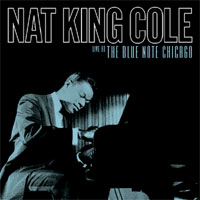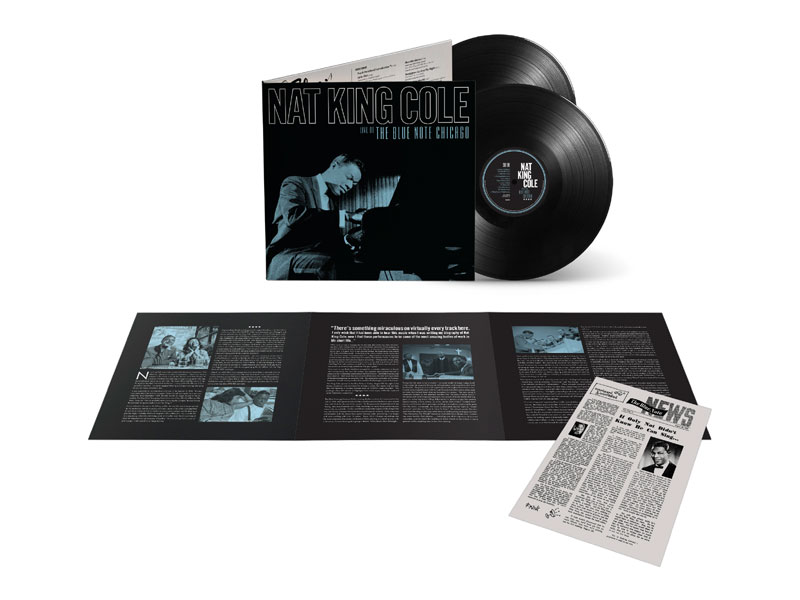Nat King Cole • Live at the Blue Note Chicago Iconic Artists Group IAG00005-LP  his is not the first special release of historic Nat King Cole
recordings on LP. That honor goes to Hittin' The Ramp: The Early Years (1936-1943),
released in 2020 by Resonance Records, which specializes in such packages, often to
coincide with Record Store Day. Live at the Blue Note Chicago was released
for Record Store Day 2024 in a vinyl edition of 4000 and CD edition of 2000. (More of both
were released a few weeks afterwards.) The biggest difference between the two sets
addresses Cole's career trajectory. Before his string of very successful Capitol records,
he led a jazz trio -- piano, guitar and bass -- and recorded some impressive sides for
several different labels, with nary a vocal sung. This is music that Hittin' The Ramp
collects. It was when he became a singer that his career took off. Over two decades, he
produced chart-toping singles and albums, and he came to rank alongside Frank Sinatra in
terms of popularity and records sold. His creamy voice and perfect phrasing made him a
master of romantic ballads; some songs -- "Mona Lisa," "Route 66,"
"It's Only a Paper Moon" -- came to be considered his. his is not the first special release of historic Nat King Cole
recordings on LP. That honor goes to Hittin' The Ramp: The Early Years (1936-1943),
released in 2020 by Resonance Records, which specializes in such packages, often to
coincide with Record Store Day. Live at the Blue Note Chicago was released
for Record Store Day 2024 in a vinyl edition of 4000 and CD edition of 2000. (More of both
were released a few weeks afterwards.) The biggest difference between the two sets
addresses Cole's career trajectory. Before his string of very successful Capitol records,
he led a jazz trio -- piano, guitar and bass -- and recorded some impressive sides for
several different labels, with nary a vocal sung. This is music that Hittin' The Ramp
collects. It was when he became a singer that his career took off. Over two decades, he
produced chart-toping singles and albums, and he came to rank alongside Frank Sinatra in
terms of popularity and records sold. His creamy voice and perfect phrasing made him a
master of romantic ballads; some songs -- "Mona Lisa," "Route 66,"
"It's Only a Paper Moon" -- came to be considered his.
It is this Nat Cole, after "King" was added to his name, that Live at the Blue Note Chicago documents. It can be considered a live greatest-hits set; "Mona Lisa," "Route 66," and "It's Only a Paper Moon" are here, along with nearly two dozen other cuts on which Cole plays piano along with guitarist John Collins, bassist Charlie Harris, and drummer Lee Young. Blue Note owner Frank Holzfeind recorded these performances over the course the ensemble's week-long stay in 1953. During that decade, the Blue Note was an iconic jazz club in Chicago. It regularly showcased internationally known musicians, including Count Basie, Duke Ellington, and Benny Goodman. In 1953, Nat King Cole was arguably a bigger name than all of them. The musical highlights here are many; the set moves along at a casual pace, an overall vibe that makes it easy to sink into the music. The sequencing follows Cole’s original set list, including transitions, crowd participation, and introductions during the show. Pairing "Our Love is Here to Stay" with "Too Marvelous" is a master's stroke; both are love songs, the first slow and dripping with emotion, the second jaunty and upbeat, the other side of the same coin. But the sequence that stands out the most is on the first side of the second LP. It begins with an interlude from Frank Holzfeind, followed by a suave version of "Walkin' My Baby Back Home" and then by a two-song medley: "Mona Lisa/Too Young." Here it's just Nat King Cole accompanied by guitar. It's serene, with Cole's singing bringing added gravity to the lyrics. Next is "Blue Gardenia," another serene number, followed by a boppish "Straighten Up and Fly Right." The atmosphere of the live performance is almost palpable, and we are firmly planted within it.
The mono sound is good, although the backing instruments are somewhat soft and distant, in keeping with recordings made in 1953. What will make audiophiles take notice is the prominence of Cole's voice, his velvety tone front and center. Kevin Gray of Cohearent Audio cut the lacquers, the LPs were pressed-on 180-gram vinyl at RTI, and they are housed in a Stoughton gatefold jacket -- audiophile cred all the way. Included is an insert that collects notes about the restoration process of the music from the original tapes by audio engineer and producer James Sàez, and an essay by author and music critic Will Friedwald, along with a replica of the club’s original newsletter promoting Cole’s residency, and a number of rare photos of Cole in and around Chicago. Hearing the vinyl is a special kick -- 70-year-old music played on the dominant format of that day. You may almost miss the pops and ticks. I grew up a few hours north of Chicago. In 1953, I wasn't
yet a gleam in my dad's eye, as he would be quick to say, but it's still meaningful for me
to think of my parents making the drive south to see Nat King Cole live. Listening to this
music, I am transported to that time, my imagination conjuring images of my mom and dad,
young and vital, among those listening and applauding. Music can do that. This music did
that. |

